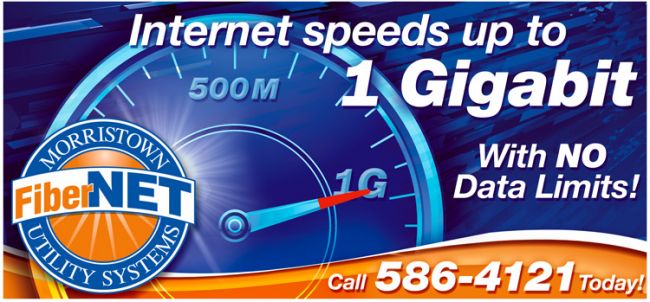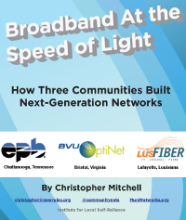
Fast, affordable Internet access for all.

Located in the northeast corner of the state of Tennessee, Morristown Utility Systems offers FiberNET to Morristown's 30,000 residents and businesses. MUSFiberNET is another community that decided to take control of its destiny and invest in a municipal broadband network. And by offering 1 Gbps anywhere in the community, Morristown is in the ultra-elite category of broadband in America.
We featured Morristown in one of the Muni FTTH Snapshots way back in June of 2009. They were doing well at the time but this great news shows how Morristown has brought next-gen, affordable, and reliable capabilities to anyone who wants it.
MUS FiberNET was built in 2006 and maintains a list of reasons why their network is superior to competitors. To advertise their incredible high capacity network, they developed this great billboard:
 Morristown's Gig announcement never received the attention given to Chattanooga or Google's roll-out in Kansas City, which is unfortunate.
For commercial users, the Gig runs $849.00 per month, a ridiculously inexpensive price point compared to what large carriers commonly charge for the service. Morristown Schools are also taking advantage of the network, including making full use of the gig service. Residential prices vary from 6 Mbps/4 Mbps, download and upload speeds, for $34.95 to 20 Mbps/10 Mbps for $74.95 and MUS FiberNET also offers a variety of triple-play bundles.
Morristown's Gig announcement never received the attention given to Chattanooga or Google's roll-out in Kansas City, which is unfortunate.
For commercial users, the Gig runs $849.00 per month, a ridiculously inexpensive price point compared to what large carriers commonly charge for the service. Morristown Schools are also taking advantage of the network, including making full use of the gig service. Residential prices vary from 6 Mbps/4 Mbps, download and upload speeds, for $34.95 to 20 Mbps/10 Mbps for $74.95 and MUS FiberNET also offers a variety of triple-play bundles.
Like many other communities in Tennessee, Morristown has few choices for service from private providers. After promising the state legislature major investments in Tennessee in return for favorable legislation, AT&T decided to only served high end, dense neighborhoods, as we have seen just about everywhere else.
Communities that are satisfied with last generation connections and having no control over the networks on which they depend can make do with AT&T and cable companies. But those who want universal access to fast, affordable, and reliable services should consider building a community fiber network.
Alcatel-Lucent, one of the key vendors behind the Chattanooga community fiber network, has produced a video highlighting life in a "smart" city.
At the current rate, EPB can shave seven years off the time it will take to pay off its telecom debt, becoming virtually debt-free by 2020 instead of 2027 as projected, Eaves [EPB CFO] said. Even so, the government utility still is spending money to sign up new customers, a process that will increase debt until 2013, Eaves said. The utility has $51 million in total debt so far, but it only needs 30,000 customers to break even on operational costs, Eaves said. "We are currently cash- flow positive from an operations standpoint, but still increasing debt to fund the capital associated with signing up new customers," he said.As we frequently remind our readers, finances are complicated. Even though the network continues to do very well, its debt will increase for a few more years while it continues rapidly acquiring new subscribers. Each subscriber takes years to pay off the debt of connecting them. Recall that EPB unexpectedly got a Department of Energy stimulus grant to deploy its smart grid much more rapidly than planned for. As the electric division owns much of the fiber fabric, the grant does not impact the finances of the Fiber-Optic division, aside from allowing EPB to roll the network out to more people more rapidly. The changed plan increased their costs and their revenues over the original plan.
“The meetings are designed to answer any questions the Tullahoma community has about the AMI technology”, said Ernie Hobbs, Communications and Marketing Specialist for TUB. “We want to assure the community that automated meter reading is the next step in providing exceptional customer service. AMI is a step forward for Tullahoma, and it will provide additional opportunities for our customers by allowing them to monitor their own usage of utilities.” The AMI installation is a replacement of current water and electric meters. The new meters can transmit usage data through TUB’s secure fiber network. The infrastructure upgrade has been in the planning stage for several years. However, with Tennessee Valley Authority (TVA) moving to Time Of Use (TOU) rates, TUB decided it was time to begin the AMI project to align with the TVA rate change.A recent newsletter from the utility explains further, noting that the Tennessee Valley Authority (a federal agency that produces the power used by Tullahoma and many other public utilities) is going to start charging time-of-use rates starting in fall of 2013. This is because electricity is more expensive to produce and distribute based on the amount being used - time of use pricing will encourage people to use more power when it is cheaper to produce and less when it is expensive. This time-of-use pricing is one component of a "smart-grid." Unfortunately, some investor-owned utilities have used time-of-use pricing to increase their revenues without substantially benefiting ratepayers -- which is one reason many are suspicious of the entire concept. Hence the public meetings. Because Tullahoma has its publicly owned network already connecting much of the community, it is better positioned to deal with TVA's changing rates than other communities.
According to a feasibility study by the utility, the third-party vendor approach would give the JCPB the best return on investment, balancing low risk with possible profits. The Power Board would provide the “backbone,” while the vendor, working under JCPB’s brand, would provide the “last mile” services and equipment to the commercial customers. The utility’s telecommunications division would be self-sustaining, and have absolutely no effect on electric rates.This seems similar to the approach of Lafayette, Louisiana almost 10 years ago. Lafayette eventually decided to build out the network to residents and all businesses when the ISPs using its network were not able to use the backbone to expand to serve everyone (the economics of building last mile fiber-to-the-home connections rarely coincide with private sector goals of maximizing short term returns). Judging from their projections, Johnson City does not need to hit particularly ambitious targets:
To reach its revenue and return on investment projections, the JCPB would need to capture about 20 percent of the area’s total market for data services, about 15 percent of the market in phone services, and about 5 percent of private data services over five years, based on a market of 3,000 commercial users.However, even those modest goals will be difficult unless they find a good, trusted partner. Most public power utilities have the trust of residents or businesses -- that trust may not extend to whoever they work with.
The lawsuit claims that, since at least July 2001, AT&T has filed monthly and annual reports listing fewer business phone lines than they actually provide. Under Tennessee law, phone companies must pay $3 per month per line to pay for 911 access. ... In a March phone service bid proposal for Hamilton County, AT&T stated it would not collect the $3 rate and instead collect $2 per line per month. That allowed the company to underbid the next lowest bidder by 69 cents per line per month, “unlawfully increasing its profits at the expense of revenue to support the critical emergency services that” 911 provided, according to court records.A difference of $.69 may not seem like much, until you consider they may be providing 1,000 lines - which is a difference of $690/month or $8,280/year.
 It is an incredible racket. AT&T gets more high-margin customers, pays less in fees than competitors, and the only people who get hurt are those who depend on 9-11.
Just when you think AT&T is brilliantly evil (an accusation I tend not to make against many corporations no matter how much I disapprove of their practices), you have to consider how incredibly incompetent they are.
It is an incredible racket. AT&T gets more high-margin customers, pays less in fees than competitors, and the only people who get hurt are those who depend on 9-11.
Just when you think AT&T is brilliantly evil (an accusation I tend not to make against many corporations no matter how much I disapprove of their practices), you have to consider how incredibly incompetent they are.